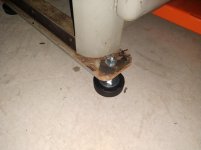What I see almost never mentioned when the subject of bed leveling comes up is why you see the effect on the work piece under cutting conditions. Anyone with a lathe needs to visualize what's actually happening. Because of the height of the cutting tool above the bed ways and the C/L of the work, a non parallel or twisted bed is multiplying that bed twist in a partial rolling motion of the tool point either towards or away from the work piece depending on which way the bed twist runs as the carriage moves along the lathe bed.
Once you have that visualization of the tool point making a short partial arc it's easy to then remember which way to turn any adjustment screws. If the work piece is larger at the tail stock end you need to go up on the front screw or down on the rear screw so the bed then counter rolls the tool point more towards the work piece. Rear screw up or front screw down if the work piece is smaller at the TS end so it then rolls the tool point away from the work. Because of that multiplication effect, a bed say .0002" out of true will have the tool point moving much more than that so you'll see a larger change than that .0002" in the diameter the lathe is producing along the work piece. And leveling a lathe bed even with the very best and most accurate level ever made is still only a static condition. Yes it will get you very close to correct, but I've always had to make further minor compensating adjustments due to how the machine parts distort and deflect under the physical loads while it's cutting. With the bed correct you then adjust the tail stock C/L to match where the bed and head stock C/L now is. With a seriously worn machine those final bed adjustments might still be too subtle to make any real difference though. At that point you need to address the root cause of the real issue with a proper rebuild. And that means a whole lot more than new paint, polish some parts and a few repairs.
There would also be a whole lot less well meant but still misinformation posted in threads about basic machine tool alignment if anyone interested would just do a simple Google search for a free online PDF of the book written by a Dr. Georg Schlesinger titled Testing Machine Tools. Print the whole thing off and then READ it enough times until the concepts of what's being tested, why and how it's done in the way he shows, and the reasons behind why some machine tool parts are purposely and very subtly misaligned for real world cutting conditions. His work in that book is recognized world wide by machine tool manufacturer's and still form the basics of any proper test certificate a half decent machine tool comes with today including the very best cnc's.





